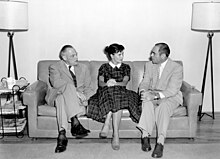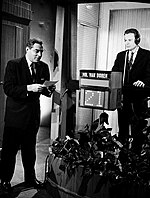
A game show is a genre of broadcast viewing entertainment where contestants compete for rewards. The shows are typically directed by a host, who explains the rules of the game as well as commentating and narrating where necessary. The history of the game shows dates back to the late 1930s when both radio and television game shows were broadcast. The genre became popular in the United States in the 1950s, becoming a regular feature of daytime television.

The 1950s quiz show scandals were a series of scandals involving the producers and contestants of several popular American television quiz shows. These shows' producers secretly gave assistance to certain contestants in order to prearrange the shows' outcomes while still attempting to deceive the public into believing that these shows were objective and fair competitions. Producers fixed the shows sometimes with the free consent of contestants and out of various motives: improving ratings, greed, and the lack of regulations prohibiting such conspiracy in game show productions.

Truth or Consequences is an American game show originally hosted on NBC radio by Ralph Edwards (1940–1957) and later on television by Edwards (1950–1954), Jack Bailey (1954–1956), Bob Barker (1956–1975), Steve Dunne (1957–1958), Bob Hilton (1977–1978) and Larry Anderson (1987–1988). The television show ran on CBS, NBC and also in syndication. The premise of the show was to mix the original quiz element of game shows with wacky stunts.
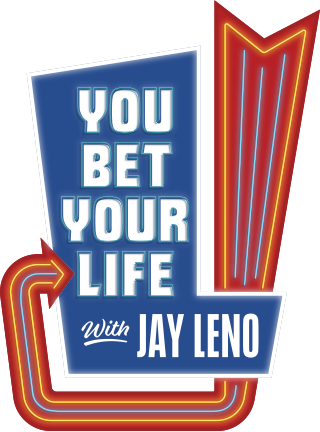
You Bet Your Life is an American comedy quiz series that has aired on both radio and television. The original version was hosted by Groucho Marx of the Marx Brothers, with announcer and assistant George Fenneman. The show debuted on ABC Radio on October 27, 1947, moved to CBS Radio debuting October 5, 1949, and went to NBC-TV and NBC Radio on October 4, 1950. Because of its simple format, it was possible to broadcast the show on both radio and television but not simultaneously. Many of the laughs on the television show were evoked by Groucho's facial reactions and other visual gimmicks; the two versions were slightly different. The last episode in a radio format aired on June 10, 1960. The series continued on television for another year, recording a season on September 22, 1960 with a new title, The Groucho Show.
The Joker's Wild is an American television game show that aired at different times between 1972 and 2019. In the show, contestants answer questions based on categories determined randomly by a mechanism resembling a slot machine. The show's title refers to the game's slot-machine mechanism also having jokers.

Twenty-One is an American game show originally hosted by Jack Barry that initially aired on NBC from 1956 to 1958. Produced by Jack Barry-Dan Enright Productions, two contestants competed against each other in separate isolation booths, answering general-knowledge questions to earn 21 total points. The program became notorious when it was found to be rigged as part of the 1950s quiz show scandals, which nearly caused the demise of the entire genre in the wake of United States Senate investigations. The 1994 film Quiz Show is based on these events. A new version of the show aired on NBC in 2000 with Maury Povich as host.
Daniel Enright was an American television producer, primarily of game shows. Enright worked with Jack Barry from the 1940s until Barry's death in 1984. They were partners in creating programs for radio and television. Their company was called Barry & Enright Productions.
Dotto was a 1958 American television game show that was a combination of a general knowledge quiz and the children's game connect the dots. Jack Narz served as the program's host, with Colgate-Palmolive as its presenting sponsor. Dotto rose to become the highest-rated daytime program in television history, as of 1958.

Tic-Tac-Dough is an American television game show based on the paper-and-pencil game of tic-tac-toe. Contestants answer questions in various categories to put up their respective symbol, X or O, on the board. Three versions were produced: the initial 1956–59 run on NBC, a 1978–86 run initially on CBS and then in syndication, and a syndicated run in 1990. The show was produced by Barry & Enright Productions.
The Who, What, or Where Game is an American television game show that was broadcast weekdays on NBC from December 29, 1969, to January 4, 1974. The host was Art James, and the announcer was Mike Darow; Ron Greenberg packaged the show, which was recorded in NBC studios 6A and 8H in Rockefeller Plaza in New York City.
Charles Haskell Revson was an American businessman and philanthropist. He was best known as a pioneering figure in the American cosmetics industry as the person who created the first pigment-based nail polish and founded and managed Revlon through five decades.

Who Do You Trust? is an American television game show.
A game show is a type of radio, television, or internet program in which contestants, television personalities or celebrities, sometimes as part of a team, play a game which involves answering trivia questions or solving puzzles, usually for prizes. Game shows are usually distinguishable from reality television competition shows, in which the competition consumes an entire season of episodes; in a game show, prizes can typically be won in a single match. Beginning with the first five-figure and six-figure game show jackpots in the mid-1950s, a succession of contestants on various quiz shows of the era each set records. Teddy Nadler of The $64,000 Challenge, the highest-scoring contestant of the 1950s era, was not surpassed until 1980, when Thom McKee won $312,700 on Tic-Tac-Dough. Between 1999 and 2001, during a brief boom in high-stakes game shows, the record was broken six times. Both the 1955–1958 and 1999–2001 eras of rapidly set and broken records were driven primarily by one-upmanship between the networks each trying to secure bragging rights and ratings by inflating their prize offerings, rather than the merits of the contestants themselves. American daytime television has historically had smaller prize budgets for game shows that air in that daypart.

The Big Surprise is a television quiz show broadcast in the United States by NBC from October 8, 1955, to June 9, 1956, and from September 18, 1956, to April 2, 1957. It was hastily created by NBC in response to the ratings success of The $64,000 Question, which had premiered on CBS in summer 1955 and almost instantly became a hit. The Big Surprise offered a grand prize of $100,000.
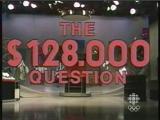
The $128,000 Question is an American game show which aired from 1976 to 1978 in weekly syndication. This revival of The $64,000 Question was produced by Cinelar Associates and distributed by Viacom Enterprises.

Strike It Rich is a game show that was broadcast on American radio from June 29, 1947 to December 27, 1957, on CBS and NBC. It was broadcast on television as well, starting in 1951. People in need of money appeared and told their tale of woe, then tried to win money by answering four questions. If the contestant did not win any money, the emcee opened the "Heart Line", which was a phone line to viewers who wished to donate to the contestant's family.
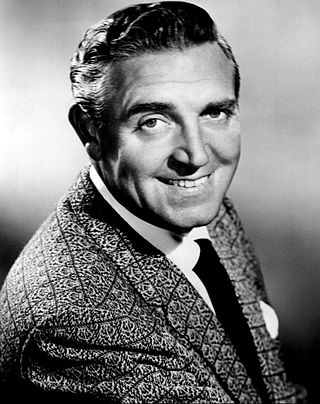
The Big Payoff is a daytime and primetime game show that premiered on NBC in 1951, and ended its network run on CBS in 1959. It had a brief syndication revival in 1962. NBC used The Big Payoff to replace the 15-minute show Miss Susan starring Susan Peters, which had gone off the air in December 1951.
Break the Bank is an American quiz show which aired variously – and sometimes co-existed in separate radio and television forms – on Mutual Radio, ABC Radio and NBC Radio Network, as well ABC, CBS and NBC television, from 1945 to 1957. From October 1956 to January 1957, NBC aired a short-lived prime-time television version called Break the $250,000 Bank.
The $64,000 Question was a British quiz show based on the US format of the same name. The show originally ran from 19 May 1956 to 18 January 1958 produced by ATV and was originally hosted by Jerry Desmonde, and called simply The 64,000 Question with the top prize initially being 64,000 sixpences (£1,600), later doubling to 64,000 shillings (£3,200). After a successful pilot was shot on 15 November 1989, the programme was revived from 1 June 1990 to 29 August 1993 with Bob Monkhouse as the host and a higher £6,400 top prize.
For Love or Money was a daytime game show that aired on CBS from June 29, 1958 to January 30, 1959, hosted by Bill Nimmo. It was one of the game shows implicated in the 1950s quiz show scandals, which led to its quick cancellation.

